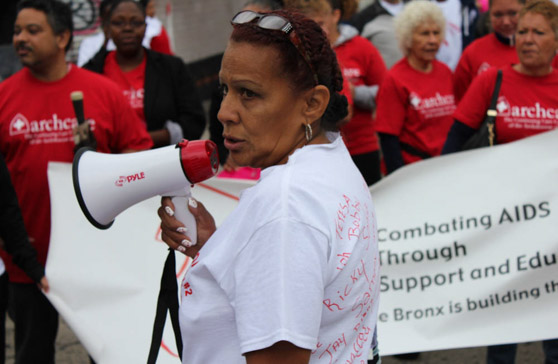
The AIDS Walk participants march down Southern Boulevard raising awareness for HIV/AIDS in the South Bronx (BENJAMIN BERGMANN/The Bronx Ink)
Against the backdrop of gray skies, the roughly 100 participants of the Third Annual Community Board 2 AIDS Walk replaced the usual truck racket in the area with the odd chants of “HIV! GET TESTED!” and “SAFE SEX! USE CONDOMS!” Marching between Westchester and Hunts Point Avenue, the group called attention to the community-wide stigma of the disease, something the organizers believe may be a key obstacle to eradicating the virus. “We need to break the silence once and for all,” said Millie Colon, a community board activist and chairperson of the AIDS Walk. “People are no longer dying for lack of medication, but rather due to a lack of communication and education.” Silence is literally killing some Bronx residents. Colon encountered AIDS over 20 years ago when her nephew passed away from the disease. Three years ago she lost her brother to AIDS, after he spent four years refusing to see a doctor for fear of community backlash. Though the fight is deeply personal for her, Colon recognizes the larger context. She urged the community to overcome the “fear barrier” of getting tested, and she encouraged those who are infected to “come out of the closet” and receive the proper medication.

Millie Colon, chairperson of the Community Board 2 AIDS Walk, rallies the marchers before the walk begins in Hunts Point (BENJAMIN BERGMANN/The Bronx Ink)
From time to time the marchers, color coordinated in red and white, stopped along the 45-minute route to listen to community voices and pray for those that have lost their lives to a disease first recorded in the city 33 years ago. One of the marchers, Carmen Rodriguez, surprised many by revealing that her husband, who had been secretly living with HIV for 25 years, passed away last Monday. “He didn’t want nobody to know” she said, gently dabbing at her mascara-stained tears. “He was in denial for many years and when he started treatment eight years ago, it had already caused too much damage.”

Carmen Rodriguez stands outside the Hunts Point Recreational Center after revealing to the group of marchers that her husband passed away from AIDS just last week (BENJAMIN BERGMANN/The Bronx Ink)
Rev. Kahli Mootoo, a Hunts Point pastor and former AIDS activist, commanded the megaphone for large parts of the walk, educating sidewalk spectators on the importance of getting tested. “The issue of HIV is losing steam” he said. “People are no longer scared of it, but does that mean they are not getting infected? Of course not!” Even though HIV numbers are consistently falling across the city according to the New York City Department of Health, the percentage of people dying from the disease continues to skew heavily towards low income neighborhoods. The Bronx has the highest death rates among the five boroughs, while Manhattan has the clearest survival advantage in New York City. These numbers were much more even back in 2005.  Though the organizers did not focus on these issues, Rev. Mootoo himself believes the issue is deeply entangled with poverty and political will. His view is that as long as HIV-related issues are contained in the most disenfranchised neighborhoods, city officials will see no reason to take action. “We always say the squeaky wheel gets the oil. Our community doesn’t have the power to squeak loud enough,” Mootoo said with a smile. “And god knows we could use some more oil around here.”
Though the organizers did not focus on these issues, Rev. Mootoo himself believes the issue is deeply entangled with poverty and political will. His view is that as long as HIV-related issues are contained in the most disenfranchised neighborhoods, city officials will see no reason to take action. “We always say the squeaky wheel gets the oil. Our community doesn’t have the power to squeak loud enough,” Mootoo said with a smile. “And god knows we could use some more oil around here.”






















